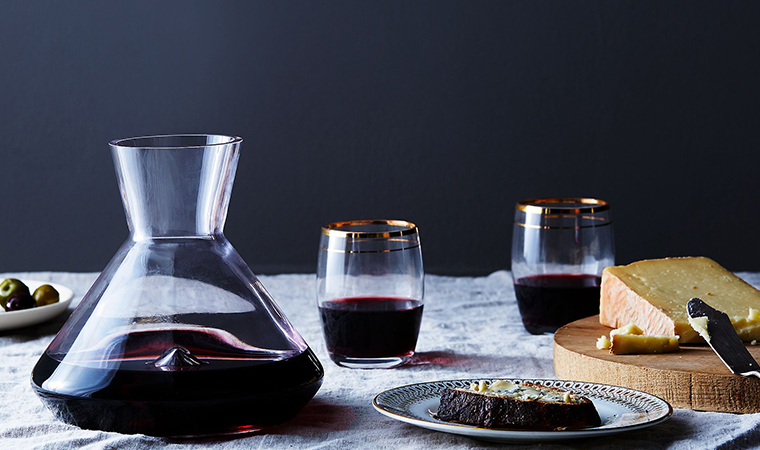We use cookies to make your experience better. To comply with the new e-Privacy directive, we need to ask for your consent to set the cookies. Learn more.
THE SIMPLE ART OF DECANTING FINE WINES

"Age improves all wines except the whine of man." - Anonymous
Elaborate swirls of crystal, regalia reminiscent of secondary chemistry and studious pouring; decanting can seem a mysterious business. Thehouseofthings demystifies the art of the decanter – and lists the process, simplifying its ambiguity for you this New Year.
The art of decanting a wine is in simple terms, transferring the wine from the bottle into another vessel, either for the purposes of removing something (sediment) or adding something (oxygen) to the wine, both of which aim to give the best possible experience for the drinker, not to forget alleviating the taste. As wine ages, especially full bodied red wines, they throw off sediment. Some is in the form of large, solid, tartrate crystals; some is complex tannin and other phenolic compounds, while some is simply tiny particles of setritus.
Knowing what, and when, to decant is another matter. Light, youthful, fresh white wines are designed for immediate drinking on release, dry Sherries and sparkling wines don’t require decanting. Red wines that have been aged in bottles may have thrown sediment. This gritty afterthought from the wine’s production doesn’t cause any harm, but is unpleasant to consume and is undesirable in a glass. As such, these wines are good candidates for decanting. Avoid decanting delicate, old, red wines as they can deteriorate very quickly once decanted. If you’re unsure, follow the maxim for mature wines; decant later rather than sooner.
Youthful red wines that have a strong tannic profile may benefit from decanting, not because of sediment but rather because exposure to oxygen accelerates development. The physical act of pouring the wine into a decanter will entice the wine to develop more quickly than if you’d simply opened and poured it straight from the bottle.

You can decant wines in a variety of ways but light is an always important factor to getting it right, it is a necessity when watching the wine being poured. Some hold the bottle and the decanter over their heads so the light shines through the bottle, others use a flash light or a candle flame for clear vision.
Many myths surround the act of decanting. For example, apparent sediment in the bottom of a wine bottle indicated that the wine is bad. Some people believe one should only decant older, mature wines. Another common myth is that only a professional – a sommelier (French for wine steward or cellar master) – should decant wines in expensive parlours. While myths of this sort may have been true years ago, decanting fine wines is a simple ritual ensuring a pleasurable tasting experience.

If you’ve made the decision to decant, it is imperative to check the condition of the wine before pouring (there is no point in decanting a corked bottle). Ideally, one should stand the wine up for 12 hours; this will allow any sediment to settle at the bottom of the bottle. Consider using a decanting funnel – a cone-shaped device with a filter section that captures the sediment as the wine is poured through it.
There are a myriad of beautiful styles of decanter available, but a clean jug works just as well – and is easier to clean afterwards. A decanter can be a glass pitcher or a carafe; many wine masters believe that the best decanter has a long neck and a wide bottom surface area, the opposite of a wine bottle.

Image: Designmilk
Double decanting (out of bottle, into decanter and back into the rinsed bottle) is great for tannic, young wines and gives you the advantage of knowing exactly what is in each bottle, rather than facing the possibility of mixing up multiple decanters. Ultimately, decanting is a personal choice; be guided by your instincts and remember decanting is not just for Port. Many wines will benefit from a careful decant and, as their drinker, so will you.
Shop Decanters on Thehouseofthings




"Age improves all wines except the whine of man." - Anonymous
Elaborate swirls of crystal, regalia reminiscent of secondary chemistry and studious pouring; decanting can seem a mysterious business. Thehouseofthings demystifies the art of the decanter – and lists the process, simplifying its ambiguity for you this New Year.
The art of decanting a wine is in simple terms, transferring the wine from the bottle into another vessel, either for the purposes of removing something (sediment) or adding something (oxygen) to the wine, both of which aim to give the best possible experience for the drinker, not to forget alleviating the taste. As wine ages, especially full bodied red wines, they throw off sediment. Some is in the form of large, solid, tartrate crystals; some is complex tannin and other phenolic compounds, while some is simply tiny particles of setritus.
Knowing what, and when, to decant is another matter. Light, youthful, fresh white wines are designed for immediate drinking on release, dry Sherries and sparkling wines don’t require decanting. Red wines that have been aged in bottles may have thrown sediment. This gritty afterthought from the wine’s production doesn’t cause any harm, but is unpleasant to consume and is undesirable in a glass. As such, these wines are good candidates for decanting. Avoid decanting delicate, old, red wines as they can deteriorate very quickly once decanted. If you’re unsure, follow the maxim for mature wines; decant later rather than sooner.
Youthful red wines that have a strong tannic profile may benefit from decanting, not because of sediment but rather because exposure to oxygen accelerates development. The physical act of pouring the wine into a decanter will entice the wine to develop more quickly than if you’d simply opened and poured it straight from the bottle.


You can decant wines in a variety of ways but light is an always important factor to getting it right, it is a necessity when watching the wine being poured. Some hold the bottle and the decanter over their heads so the light shines through the bottle, others use a flash light or a candle flame for clear vision.
Many myths surround the act of decanting. For example, apparent sediment in the bottom of a wine bottle indicated that the wine is bad. Some people believe one should only decant older, mature wines. Another common myth is that only a professional – a sommelier (French for wine steward or cellar master) – should decant wines in expensive parlours. While myths of this sort may have been true years ago, decanting fine wines is a simple ritual ensuring a pleasurable tasting experience.


If you’ve made the decision to decant, it is imperative to check the condition of the wine before pouring (there is no point in decanting a corked bottle). Ideally, one should stand the wine up for 12 hours; this will allow any sediment to settle at the bottom of the bottle. Consider using a decanting funnel – a cone-shaped device with a filter section that captures the sediment as the wine is poured through it.
There are a myriad of beautiful styles of decanter available, but a clean jug works just as well – and is easier to clean afterwards. A decanter can be a glass pitcher or a carafe; many wine masters believe that the best decanter has a long neck and a wide bottom surface area, the opposite of a wine bottle.


Image: Designmilk
Double decanting (out of bottle, into decanter and back into the rinsed bottle) is great for tannic, young wines and gives you the advantage of knowing exactly what is in each bottle, rather than facing the possibility of mixing up multiple decanters. Ultimately, decanting is a personal choice; be guided by your instincts and remember decanting is not just for Port. Many wines will benefit from a careful decant and, as their drinker, so will you.
Shop Decanters on Thehouseofthings















